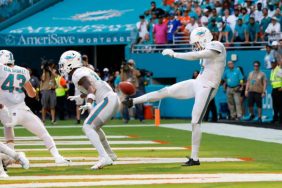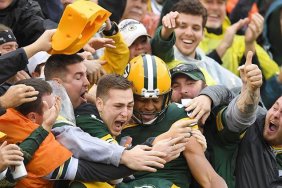When it comes to the professional sports landscape in the United States, football is king. And for the last several decades, the National Football League has become an immoveable object, swallowing up any opponent that stands in its way while growing into a business worth more than $2 billion.
But that success has come with a price in recent years, as some of the country’s top medical professionals have linked tackle football with chronic traumatic encephalopathy, a degenerative brain disease believed to be caused by excessive blows to the head. It’s an ongoing issue that continues to dominate the front page. CTE can be found in other professional sports such as ice hockey or boxing, but nowhere is it more prevalent than tackle football – and with children starting their participation at a young age, it’s all cause for concern.
Parents and children alike want an alternative way to enjoy the sport, one that offers the same speed and skill but lacks the physicality that may cause serious, irrefutable damage to the body. As sports such as soccer see a rise in participation at the youth level, the hunger for Americanized football remains, which could be why some are turning to flag football to help fill that void.
Flag football is one of the fastest growing sports in the United States, with more than 1.6 million participants between the ages of 6 and 14 in 2015, up 8.7 percent from the year before, according to a study done by USA Football.
It was this popularity at the youth level that gave Jeff Lewis an idea back in 2014 while watching his sixth grade son play flag football. Lewis, a Manhattan resident, was immersed in the city’s vibrant flag football culture and coached his fair share of teams when, on his way home from an exciting loss, he asked himself what flag football would be like if it was played by great athletes – world-class athletes.
Within no time, Lewis began work on establishing the American Flag Football League (AFFL), a professional flag football league that would strip the game down to its roots, eliminating everything that fans have grown to hate and emphasizing the best that football has to offer. But how can a 30-year bond trader and hedge fund manager build a professional sports league and survive against the NFL?
DITCHING THE PADS FOR FLAGS
Armed with an excessive amount of research, Lewis and his partners learned from former NFL players that flag football is the basis for developing the skills necessary to be successful in tackle football. The AFFL takes a traditionally 11-on-11 sport and trims it down to 7-on-7. While that reduction seems bizarre to the traditional football fan, most teams at the collegiate and professional level are well versed in the format — actually only hitting once, maybe twice per week, with pads in practice.
“The Ivy League doesn’t hit at all in practice, they go all week without playing the game they play on Saturday – the NFL hits once a week,” Lewis said in a phone interview. “Most of the reps the skill players are getting as they develop as tackle football players are actually in 7-on-7. Most of the football that gets played is without helmets, without shoulder pads, without tackling, without hitting.”
Football without the physicality might seem like a tough sell to traditional NFL fans but that might not necessarily be the case if you look at the data collected through various social media outlets. Lewis wanted to better understand what fans were talking about during NFL games and while the high importance plays were there, little was said about the physical, bone-crushing plays of contests.
“[Fans] don’t discuss tackles, or blocks, or hits, or sacks,” Lewis added. “They discuss runs, passes, catches, interceptions – the spectacular plays. What really draws people to football is the stuff that is still present in our game and our theory is that a lot of what drives you away from, or towards, something like this is going to be how familiar it is and whether it has the feel of what you love.”
Lewis also mentioned NFL Red Zone, a television channel devoted to the scoring plays each week and the fact that there’s no essential programming that highlights the week’s physical plays.

THE TALENT POOL
As the XFL learned more than 15 years ago, without talent a league is doomed to fail. Mediocre football is something fans will not tolerate and if a league tries to hide lackluster talent, fans will jump ship.
This isn’t any worry for Lewis and the AFFL, as there’s a wealth of talent available. And while many football fans reached out about a potential try out, Lewis has a formulaic way of doing things. It means looking at different avenues – from former collegiate players, to fringe NFL players, to superstars.
“I can’t even begin to tell you how many unsolicited requests we’ve had from people who want to play,” Lewis said. “But, ultimately, what we are going to find are people that are great. They’re not necessarily going to be in the mold that our NFL players come from. Part of what is going to be so fun about this process, as this sport develops, is that we sort of open up football and make it a little more accessible to a wider variety of athletes. So you don’t necessarily have to have the build and the makeup to handle the physical toll that playing tackle football takes. We will find smaller guys and skinnier guys and we will find quarterbacks of every size. You’re going to end up seeing people emerge.”
One of those quarterbacks will be former NFL superstar Michael Vick. Drafted first overall in the 2001 NFL draft, Vick went on to redefine the position and holds the record for most rushing yards by a quarterback in a season and in a career, while also earning four trips to the Pro Bowl in 13 seasons. Vick is the perfect quarterback for the AFFL and fans who played the Madden video game franchise a decade ago would agree, given his speed and ability to accurately bomb the football – even at 36-years-old.
“We reached out to a large number of players and, obviously, stylistically when you think about the nature of this game, [Vick] would be your ideal player. If you were the General Manager and you were going to draft a quarterback, you would want somebody who really has exactly his qualities. This is a speed game and to have a multi-dimensional quarterback like him would be perfect.”

Falcons Michael Vick #7 throws during first half action between the Atlanta Falcons and the Tennessee Titans on August 26, 2006 at The Coliseum in Nashville, Tennessee.
THE SPEED OF THE GAME
One of the biggest knocks on the current experience of NFL games is the speed. With countless commercials and roughly 12 minutes of actual action, the game is disrupted. Lewis understands this problem and vows to make AFFL games about two hours, plenty of time to complete 60 minutes.
“There’s a trap you can fall into,” Lewis claimed. “It becomes very alluring to just keep layering on more and more breaks so you can continue to add more and more advertising, because every ad is more money, right? But eventually, at some point, the fan starts to sort of say ‘enough, you can’t just take my attention for granted’ and at some point you’re going to lose [the fan’s attention]. You have to respect the fact that people don’t want their time wasted, that they actually don’t want to give you three hours and 15 minutes of their life to find out the result of a football game. So, we’re going to do everything we can to play 60 minute football games and get them done in two hours or less.”
Games will be held on a full, regular-size field because Lewis believes keeping the scale of the game is something essential for the fan experience. Quarterbacks will still drop back and pop off passes, despite the lack of an offensive line, something fans are accustomed to witnessing. Add in a smaller rule book and a shorter play clock in between plays and it’s clear the focus is on the fan experience.
“With the technology we have and the rules we have in place, you should see a game that flows much more and has much less intervention and interruption by the officials, by commercials and so on.”
THE GRIDIRON
On June 27, the AFFL will host its inaugural game at 6:30 p.m. at Avaya Stadium in San Jose, Calif. – home to the San Jose Earthquakes of Major League Soccer. While San Jose isn’t a traditional football market, it’s within a stone’s throw of Santa Clara, the home of the NFL’s San Francisco 49ers.
Avaya Stadium holds just over 18,000 spectators, which might just be the perfect size for the league’s first event. Lewis believes MLS stadiums such as this one could help the league evolve and expand.
“One of the things about going to sporting events is, whether you watch them on TV or attend them in person, it just feels better when a game is well attended. So, if we played at the big house at [University of Michigan] and we had 50,000 people there, it would look like no one showed up. We are very interested in all of these Major League Soccer stadiums because, basically, all over the country now you have these 15,000 to 20,000 seat outdoor facilities that are 10 years old. If we put 10,000 people in [Avaya Stadium] and we seat them properly, it will feel full, it will feel like it’s important – it’ll feel fun.”
At the end of the day, fun is the emphasis of the AFFL and Lewis doesn’t want that getting lost in the numbers – but only time will tell if it can outlast the XFL and the United States Football League.
“We are football fans, we want it to feel like football,” Lewis declared. “We don’t want people to say I’m watching flag football, we want them to say football.”
Ed Miller is a contributor for CraveOnline Sports, a movie quote extraordinaire and a proud Sun Devil. You can follow him on Twitter @PhillyEdMiller or “like” CraveOnline Sports on Facebook.
Photo: Getty








